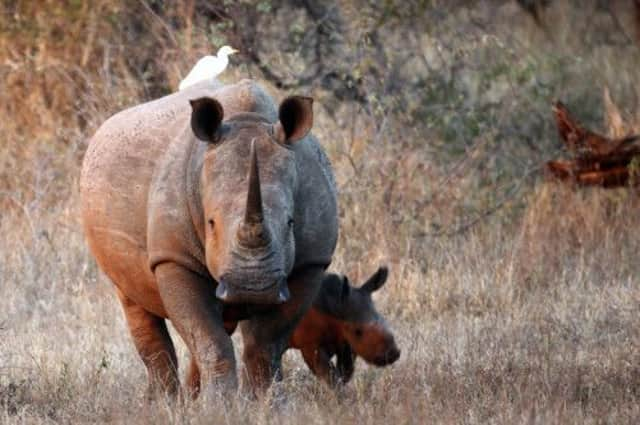South Africa: More rhinos killed this year than 2012


The slaughter threatens the rhinoceros population in the African country which is home to more of the animals than any other in the world.
By the end of last month, 704 rhinos had been killed by poachers in South Africa, exceeding the previous high of 668 set for the whole of 2012, according to new data from the environmental affairs ministry.
Advertisement
Hide AdAdvertisement
Hide AdIf the trend continues at its current pace, more than 1,000 rhinos would be killed next year, putting the species on the brink of a population decline that the ministry has said could lead to the end of rhinos in the wild in about a decade.
The greatest threat to the estimated 22,000 rhinos in South Africa – 18,000 white and 4,000 black – comes from people trying to cash in on the illegal market value of their horn, which sells at prices higher than gold.
Many of the poachers come from neighbouring Mozambique and sell the horn to crime syndicates to meet demand in South-east Asia, where the horn is thought by some to cure cancer and tame hangovers.
South African authorities have arrested 219 suspected poachers this year, but none of the kingpins who control the trade.
“We need people to be ashamed of this. The fact that our rhinos are killed is because there is a market out there. There are people who are coming to steal our heritage,” said Fundisile Mketeni, a top biodiversity official at the ministry.
He said a baby boom among rhino stocks was softening the blow, while the ministry has mounted a global campaign to shut the doors on illegal exports to places such as Vietnam, China and Thailand, the main consumers of the contraband.
Most of the killings are taking place in the flagship Kruger National Park, which borders Mozambique. The park covers 7,580 square miles and has been the focus of an arms race between poachers and rangers. The park service has been turning its rangers into soldiers, using drones to patrol airspace and sending out crack units by helicopter once suspected poachers have been sighted.
“The poaching syndicates are determined to carry on with their nefarious acts, using the poverty that is prevalent in Mozambique and South Africa to recruit poachers,” said Ike Phaahla, a spokesman with South African National Parks.
Advertisement
Hide AdAdvertisement
Hide AdUp until about 2010, only a handful of rhinos were poached but the number increased when rumours circulated at about that time that a Vietnamese minister’s relative was cured of cancer by rhino horn. There is no basis in science to support the claim.
Vietnam’s last native rhino was killed in 2010.
In traditional Chinese medicine, the horn was used to treat maladies from rheumatism to devil possession. Now, many newly rich Vietnamese consume it after a hard night of partying.
Rhino horn, once seen as a treatment only for royalty, is being swallowed by a small segment of the Vietnamese population who can afford prices of about £40,000 a kilo.
Due to the high costs, much of the so-called rhino horn sold at pharmacies in major cities is fake, with buffalo horn the main substitute.
“There is a small group who have the money for rhino horn. We need to get out scientific evidence to show the people of Vietnam that it doesn’t work,” Vo Tuan Nhan, vice-chairman of the Vietnamese parliament’s science and environment committee, told a seminar in Johannesburg last month.
A World Wide Fund for Nature investigation in Vietnam this year found the average consumer of rhino powder was 48 years old and a businessman.